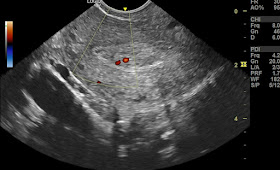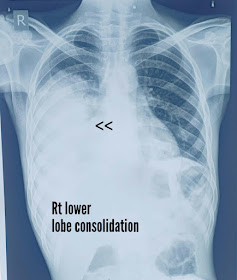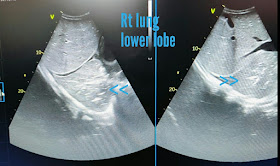The patient is a 45-year-old male who presented with left flank pain for two weeks. He had no history of urinary tract infections, hematuria, or previous renal stones. He had normal renal function tests and urine analysis.
He underwent an ultrasound scan of the left kidney, which showed the following findings:
- A calculus of 10 mm in the PUJ, which is the junction between the renal pelvis and the ureter. This is also known as UPJ calculus. This calculus causes a partial obstruction of the urine flow from the kidney to the bladder, resulting in dilation of the renal pelvis and calyces. This is called hydronephrosis. The degree of hydronephrosis is moderate in this case, as the renal parenchyma is still visible and not completely compressed by the urine in the dilated pelvicalyceal system.
- Another smaller renal calculus of 4 mm in the lower pole of the kidney. This calculus does not cause any obstruction or hydronephrosis, but it may cause pain or hematuria if it moves or grows.
- Two ultrasound images and two color Doppler ultrasound images are shown below.
Ultrasound image of PUJ calculus:
Ultrasound image of lower pole calculus:
Color Doppler image of PUJ calculus with twinkle artifact:
Color Doppler image of PUJ calculus:
The ultrasound images show the cross-sectional views of the kidney, with the PUJ calculus marked by an arrow. The color Doppler images show the blood flow in the renal vessels, with the PUJ calculus producing a characteristic "twinkle" artifact. This artifact is caused by the reflection of the Doppler signal from the surface of the calculus, creating a color noise that resembles a twinkling star. This artifact helps to differentiate a calculus from other causes of acoustic shadowing, such as air or bone.
For more on this topic visit:
#Prognosis:
The prognosis of PUJ obstruction with renal calculi depends on several factors, such as the size and location of the calculus, the degree and duration of the obstruction, the presence of infection or inflammation, and the renal function of the patient.
In general, small calculi (<5 mm) have a high chance of spontaneous passage, while larger calculi (>10 mm) have a low chance of spontaneous passage and may require intervention. The PUJ is a narrow and curved segment of the ureter, which makes it more prone to obstruction by calculi. The obstruction can cause renal damage due to increased pressure, ischemia, and infection. The extent of renal damage can be assessed by measuring the differential renal function (DRF), which is the percentage of total renal function contributed by each kidney. A DRF of less than 40% indicates significant renal impairment and may warrant surgical correction of the obstruction.
The presence of another smaller renal calculus in the same kidney increases the risk of recurrent stone formation and obstruction. Therefore, the patient should be advised to follow preventive measures, such as increasing fluid intake, reducing dietary oxalate and sodium, and taking medications to modify urine pH or composition, depending on the type of the calculus.
# Management:
The management of PUJ obstruction with renal calculi depends on the symptoms, the ultrasound findings, and the patient's preference. There are several treatment options available, and these will be discussed with the patient. These include:
- Active surveillance with careful observation and repeated scans. This option is suitable for asymptomatic patients with small calculi and mild hydronephrosis, who have a high chance of spontaneous passage of the calculus. The patient will be monitored for any changes in symptoms, renal function, or ultrasound findings, and will be offered intervention if there is any deterioration or complication.
- Surgery. This option is suitable for symptomatic patients with large calculi and severe hydronephrosis, who have a low chance of spontaneous passage of the calculus and a high risk of renal damage. There are different types of surgery that can be performed to remove the calculus and relieve the obstruction, such as:
- Laparoscopic (keyhole) pyeloplasty. This is a minimally invasive surgery that involves making small incisions in the abdomen and using a camera and instruments to cut and rejoin the PUJ, creating a wider and smoother junction. The calculus is also removed during the procedure. This surgery has the advantages of less pain, faster recovery, and better cosmetic outcome than open surgery.
- Endopyelotomy (with laser). This is an endoscopic surgery that involves inserting a thin tube (ureteroscope) through the urethra and bladder into the ureter, and using a laser to cut the PUJ from inside, creating a larger opening. The calculus is also removed during the procedure. This surgery has the advantages of avoiding abdominal incisions and preserving the renal vessels, but it has a higher risk of recurrence and stricture formation than pyeloplasty.
- Long-term ureteric stent. This is a temporary or permanent placement of a thin plastic tube (stent) in the ureter, which bypasses the obstruction and allows the urine to drain from the kidney to the bladder. The stent can be inserted through the ureteroscope or through a small incision in the back (percutaneous nephrostomy). The stent can also help the calculus to pass or dissolve over time. This option has the advantages of being less invasive and more effective than surgery in some cases, but it has the disadvantages of causing discomfort, infection, and encrustation.
(1) Pelviureteric Junction Obstruction(PUJO) Treatment | NU Hospitals. https://www.nuhospitals.com/surgeries/pelvi-ureteric-junction-obstruction.
(2) Pelviureteric junction obstruction | Radiology Reference Article .... https://radiopaedia.org/articles/pelviureteric-junction-obstruction-1?lang=us.
(3) Pelvi-Ureteric Junction (PUJ) Obstruction - Bristol Urology Associates. https://www.bristolurology.com/pelvi-urethric-junction-puj-obstruction/.
(4) Urolithiasis management in kidneys with anomalies - Our institutional study. https://www.iosrjournals.org/iosr-jdms/papers/Vol21-issue7/Ser-2/A2107020107.pdf.
(5) Pelviureteric Junction Obstruction(PUJO) Treatment | NU Hospitals. https://www.nuhospitals.com/surgeries/pelvi-ureteric-junction-obstruction.
(6) Pelviureteric junction obstruction | Radiology Reference Article .... https://radiopaedia.org/articles/pelviureteric-junction-obstruction-1?lang=us.
(7) Pelvi-Ureteric Junction (PUJ) Obstruction - Bristol Urology Associates. https://www.bristolurology.com/pelvi-urethric-junction-puj-obstruction/.
(8) Urolithiasis management in kidneys with anomalies - Our institutional study. https://www.iosrjournals.org/iosr-jdms/papers/Vol21-issue7/Ser-2/A2107020107.pdf.
(9) The 35 Best Radiology Newsletters, Blogs, and Websites to Follow. https://theimagingwire.com/2023/03/05/the-35-best-radiology-newsletters-blogs-and-websites-to-follow/.
(10) What Are The Best Radiology Blogs Out There? - RadsResident. https://radsresident.com/2019/05/16/best-radiology-blogs/.
(11) Voice of Radiology Blog | American College of Radiology - ACR. https://www.acr.org/Advocacy-and-Economics/Voice-of-Radiology-Blog.
(12) Imaging 3.0 Case Studies | American College of Radiology - ACR. https://www.acr.org/Practice-Management-Quality-Informatics/Imaging-3/Case-Studies.
















































